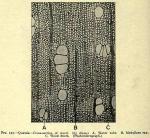
 Related entry: Quassia bark
Related entry: Quassia bark
The wood of Picrasma excelsa (Swartz) Planchon, known commercially as Jamaica Quassia, or of Quassia amara Linné (Surinam Quassia).
BOTANICAL CHARACTERISTICS.—A tree resembling the common ash, attaining a height of 50 or 60, even 100, feet. Leaves pinnate, with an odd leaflet; leaflets opposite, 4 to 8 pairs. Flowers small, pale yellowish-green, in loose panicles, polygamous. Fruit drupaceous, globose, glossy, black.
HABITAT.—Jamaica and other West India islands.
DESCRIPTION OF DRUG.—Imported in dense, tough billets, often 300 mm. (12 in.) thick, freed from the thick, tough bark. The yellowish-white or white raspings or chips are usually employed in pharmacy. The tissue consists mostly of prosenchyma, associated with long woodfibers with tapering ends, and ducts which, on transverse sections of the wood, appear as pores; inodorous; taste intensely bitter. Quassia tonic drinking cups are made from the wood on a turning lathe; water poured into them acquires a bitterness, in a few minutes, of which the wood seems inexhaustible.
Quas'sia amar'a Linné, Surinam Quassia, comes in much thinner billets, and has a thin,, brittle bark, it seldom reaches our market. It may be distinguished from the Picrasma excelsa (Jamaica quassia) by the fact that the medullary rays in the former consist of single rows of cells, while those of the latter consist of three rows each. The cells composing the rays in the Q. amara are of equal size, and their radial walls appear wavy in tangential section; whereas the corresponding cells in P. excelsa are of variable size and exhibit regular walls in tangential section. The true source of Quassia is said, by some authorities, to be a simaruba.
Powder.—Characteristic elements: See Part iv, Chap. I, B.
CONSTITUENTS.—Picras'ma excel'sa contains a bitter neutral principle, picrasmin, Quas'sia amar'a, an analogous principle, quassin, both soluble in water, alcohol, and chloroform. The principles can easily be obtained from the precipitated tannate by mixing it with lead carbonate, drying, and extracting with alcohol. They crystallize from alcoholic solution in needles; purified by recrystallization. Quassia contains no tannin, and therefore can be prescribed with salts of iron.
Preparation of Quassin.—Neutralize infusion with NaOH; add tannin to precipitate the neutral principle; heat with lead oxide or lime to decompose precipitate, and dissolve out with alcohol. White, opaque, very bitter. Soluble in hot alcohol, chloroform; slowly in water.
Preparation of Picrasmin.—Precipitate tannate with lead acetate, the former obtained by precipitating the neutral infusion with tannin. In needles; very soluble in hot alcohol, chloroform, acetic acid, but sparingly in water.
ACTION AND USES.—A valuable simple bitter tonic. Dose: 15 to 60 gr. (1 to 4 Gm.). It is poisonous to insects, a strong infusion being often used as a parasiticide on animals.
OFFICIAL PREPARATION.
Tinctura Quassiae (20 percent.), Dose: 30 to 60 drops (2 to 4 mils).

